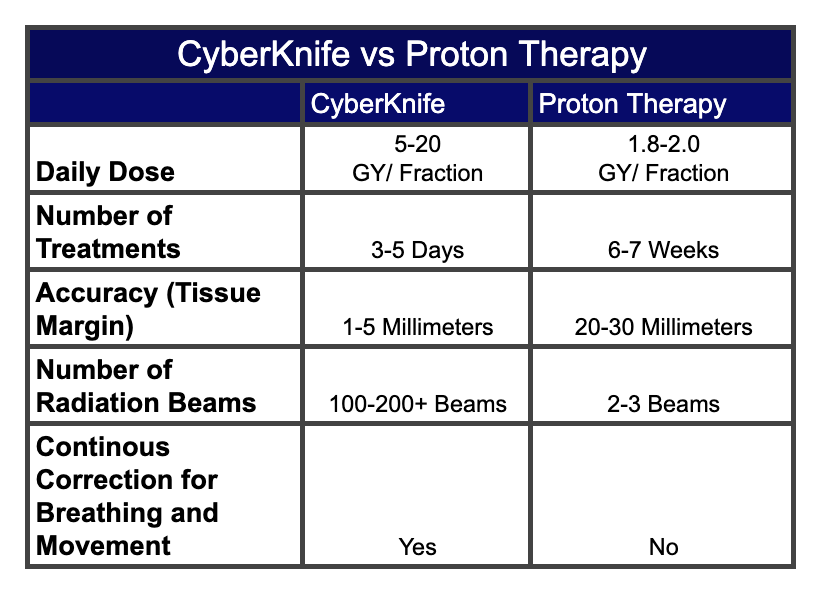If you have prostate cancer, you should if you haven’t already done your homework. If you did, you should have heard or been told about two forms of non-invaisive or alternative prostate cancer treatments. CyberKnife Therapy and Proton Beam.
Both are targeted forms of radiation therapy.
Proton Therapy is an advanced form of particle therapy that uses low doses of radiation beams to destroy diseased tissue – and is known for its precision and minimal side effects. So how is it any different from the CyberKnife® system?
Both these forms of radiotherapy (radiation therapy) target cancerous and non-cancerous tumors differently, which is a key factor that needs to be considered before undergoing prostate cancer treatment.
What Is Proton Therapy?
During Proton Therapy (also called Proton Beam Therapy), the doctor targets the part of a patient’s body where the tumor is located and exposes the area to proton beams. These charged particles then damage the cancer cells and ultimately destroy them and prevent them from reproducing.
However, surrounding tissue or organs may also be affected by the Proton beams.
What Is CyberKnife Therapy?
During CyberKnife treatment – which is a very popular prostate cancer therapy – high doses of radiation are delivered to the tumor with extremely accurate, sub-millimeter precision. This precision virtually eliminates or minimizes any damage to nearby healthy tissue.
What Exactly are the Differences Between CyberKnife and Proton Therapy Treatments?
There are many key differences between CyberKnife and Proton Therapy, which include the following:
· The unit of radiation with Proton Therapy is 1.8 to 2.0 Gy per fraction, as compared to 5 to 20 Gy per fraction with CyberKnife.
· The length of treatments necessary with Proton Therapy is 6 to 7 weeks, as compared to 3 to 5 days with CyberKnife.
· The accuracy (tissue margin) with Proton Therapy is 20 to 30 millimeters, as compared to only 1 to 5 millimeters with CyberKnife.
· The number of radiation beams with proton therapy is 2-3, as compared to 100-200+ beams with CyberKnife.
Plus, with Proton Therapy, there is no continuous correction for patient movement, whereas the CyberKnife system’s robotic arm makes immediate adjustments. This keeps the radiation beams focused on its target with sub-millimeter accuracy, thus preventing damage to healthy tissue.
This is especially important because a person has natural bodily movements, such as when breathing or as the bladder fills with urine (which can move the prostate). CyberKnife moves as the tumor moves.
Which Radiation Treatment Should I Choose?
CyberKnife and Proton Therapy are two of the many treatment options to consider if you have been diagnosed with prostate cancer or other type of tumor. Of course, the right treatment for you will depend on the location, size, and stage of your tumor.
To determine the option that best suits your needs, talk with your physician. Keep in mind that CyberKnife – often referred to as the Beam of Life – is an effective, pain-free, noninvasive course of therapy that has minimal if any side effects and rarely requires any recovery period. Some patients report feeling a little tired afterwards but it quickly goes away.
Prostate Cancer Treatment in Miami
At the CyberKnife Center of Miami, we understand the challenges you face as a prostate cancer patient – and we are dedicated to your care and successful recovery. We are always available to answer any questions or concerns you might have, and we are committed to making your treatment experience as comfortable and efficient as possible.
Contact us to see if you or a loved one is a candidate for prostate cancer treatment using CyberKnife technology. Our number is (800) 204-0455.
Or click here and contact us right now using our online form. Our goal is to help our prostate cancer patients live longer, healthier lives and maintain quality of life throughout their treatment and beyond.
For all the latest cancer news follow us on FACEBOOK – INSTAGRAM & YOUTUBE

